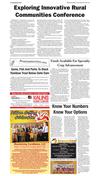032018_YKBP_A9.pdf




Broadcaster Press 9
March 20, 2018 www.broadcasteronline.com
National Ag Week
March 19-23, 2018
USDA Announces More Local Control
for School Meal Operations
USDA Press
WASHINGTON, March 5, 2018 – U.S.
Department of Agriculture (USDA) Deputy
Secretary Steve Censky today announced
two new efforts to provide states and
school districts with additional flexibility
and support to operate more efficient
school meal programs. Censky made the
announcement during a speech at the
School Nutrition Association Legislative
Action Conference in Washington, D.C.
Child Nutrition Hiring Flexibility Rule
In 2015, USDA established education
and training requirements for nutrition
professionals as part of the Healthy,
Hunger-Free Kids Act of 2010. While this
strengthened many school meal programs, some small school districts faced
challenges finding qualified applicants to
direct their local food service operation.
Today’s proposal would provide muchneeded relief for school districts with less
than 2,500 students, allowing them more
flexibility in the hiring of new school
nutrition program directors.
“Small and rural school districts will
no longer have to overlook qualified food
service professionals because of one-sizefits-all standards that don’t meet their
needs," said Censky. “We trust our local
partners to hire talented school nutrition
program directors who will manage the
meal service in a way that protects the
health and well-being of students.”
USDA is providing a 60-day public
comment period and will then develop a
final rule that responds to the needs of
partners and stakeholders.
Child Nutrition Integrity Efforts
To support states’ efforts to improve
program integrity, USDA also rolled out a
suite of customizable resources to help
local school districts improve the accuracy of their school meal application processes. These resources include support
for online applications, evidenced-based
materials, and best practices to simplify
the process for families and ensure that
eligible children receive free and reducedpriced meals.
“USDA’s goal to do right and feed
everyone starts with our children,” said
Censky. “We are committed to giving
states and school districts more tools and
options to build a bright, self-sufficient
future for America’s children through
well-managed school meal programs.”
As part of this package, USDA is offering guidance to help schools utilize its
award-winning, open-source online school
meal application model. USDA developed
the application with input from local food
service professionals. The customerfriendly design of the model is intended
to increase the integrity of the application
process by reducing common mistakes
families make when applying for free or
reduced-priced school meals.
“These tools are the benchmark for
future innovation and give schools 21st
century resources and strategies to run
efficient food service operations, now and
into the future,” Censky said. “Schools
can ensure the proper use of funds for
feeding students in need, protecting the
taxpayer dollar through high integrity
programs.”
USDA invites software developers in
private industry to join schools in delivering customer service by helping them
tailor their own applications.
Today’s announcement is the latest in
a series of recent USDA actions to expand
flexibility and ease challenges for partners and stakeholders who help feed our
nation’s children. Other actions include:
• Publishing the School Meal Flexibility
Rule, which provides local food service
professionals the flexibility they need to
serve wholesome, nutritious, and tasty
meals in schools across the nation.
• Releasing “The Food Buying Guide,”
a mobile app that puts critical information at the fingertips of food service professionals and makes it easier for them
to plan wholesome, nutritious, and tasty
school meals.
• Selecting Kansas State University
to direct the Center for Food Safety in
Child Nutrition Programs, which will help
improve food safety across all of USDA’s
child nutrition programs.
• Inviting the public to submit ideas
on food crediting, the system that defines
how each food item contributes to meal
requirements under the National School
Lunch Program and other federal child
nutrition programs.
About 100,000 schools and institutions feed 30 million children through
the National School Lunch Program and
nearly 15 million children through the
School Breakfast Program. Many of these
children receive their meals at no cost or
for a reduced price according to incomebased eligibility.
USDA’s Food and Nutrition Service
(FNS) administers 15 nutrition assistance
programs, including the National School
Lunch and School Breakfast programs,
the Child and Adult Care Food Program,
the Summer Food Service Program, the
Special Supplemental Nutrition Program
for Women, Infants and Children, and the
Supplemental Nutrition Assistance Program, which together comprise America's
nutrition safety net.
Jones & Mellette County 4-H Junior Leaders Visit the Capitol
by SDSU iGrow
BROOKINGS, S.D. - Members of the Jones
and Mellette Counties 4-H Junior Leaders
group traveled to Pierre for a Legislative
visit.
"It is through becoming aware of the
legislative process that youth gain civic
mindedness and a desire to inspire change
within their community," said Kaycee Jones,
SDSU Extension 4-H Youth Program Advisor
for Haakon, Jackson, Jones & Mellette Counties.
The Jones and Mellette County 4-H
Junior Leaders include; representing Jones
County - Matthew Birkeland, Dylan Fuoss
and Bridger Hight; representing Mellette
County - Elisabeth Gullickson, Tyson Hill,
Tashina Red Hawk and Seth Schoon.
During the one-day event, the teens
gained insight into how the South Dakota
state legislative process works. The youth
sat in on the Joint Committee on Appropriations and Senate Agriculture and Natural
Resources Committee and House Transportation Committee meetings and attended
the Democratic Caucus. They were invited
to sit on the House floor during session and
were given a tour of the Capitol by Mary
Haugaard, a Draper High School alumnus
and wife of Representative Steven Haugaard.
"This trip taught me that bills take a lot
of time and work to become laws," said Dylan Fuoss, a Jones County 4-H Junior Leader.
Throughout the day, many of the state's
legislators took time out of their schedule to
visit with the 4-H Junior Leaders. When the
issue of non-meandered waters came up
during the Natural Resources Committee
meeting, the topic interested many of the
members who are avid hunters and enjoy
spending time outdoors.
"Senator Troy Heinert, who serves
on the Senate Agriculture and Natural
Resources Committee was able to spend
time visiting with the youth following the
completion of the meeting and invited our
group to the floor of the Senate chambers
where he provided insight into the nonmeandering water bill and also the entire
legislative process," Jones explained.
Jones added that it was through the efforts of Representative James Schaefer and
Speaker of the House Mark Mickelson that
the youth were able to sit on the House
floor during session.
"The 4-H'ers really gained an in-person,
real-world view of the process of the legislative process," Jones said.
While the youth were in Pierre, they also
toured the South Dakota Cultural Heritage
Museum.
"This trip was fun and a great experience
to learn about our government. I would recommend this trip to anyone," said Matthew
Birkeland, a Jones County 4-H Junior Leader.
More about South Dakota 4-H
SDSU Extension's 4-H Youth Development
Program is a partnership of federal (USDA),
state (Land Grant University), and county
resources through youth outreach activities
Courtesy of iGrow. Members of the Jones and Mellette Counties 4-H Junior Leaders group traveled to Pierre for a Legislative visit. Back row: Kaycee Jones, SDSU
Extension 4-H Youth Program Advisor - Haakon, Jackson, Jones & Mellette Counties.
Middle Back: (left to right) Tashina Red Hawk, Bridger Hight and Seth Schoon. Middle front: (left to right) Elisabeth Gullickson and Dylan Fuoss. Front row: (left to right)
Matthew Birkeland and Tyson Hill.
of SDSU Extension. Youth learn and experience Leadership, Health and Wellness,
Science and Ag-Vocacy through a network of
professional staff and volunteers reaching
more than 9,000 enrolled members with
yearly programming efforts to an additional
35,000 youth participants.
To learn more, contact your local SDSU
Extension 4-H Youth Program Advisor. A
complete listing can be found at iGrow
under Field Staff Listing icon.
THE STRIP TILL
ADVANTAGE
Elk Point, SD
SERVICES AVAILABLE
• Custom Strip Till
• GPS Soil Sampling
• Soil Fertility Planning
• Crop Scouting
• Variable Rate Fertility
Call to discuss Spring Strip Till options
JOEY HANSON
Crop Consultant/CCA
605.659.4783 • joey.hanson@diversifiedagronomy.com
• Highly efficient use of fertilizer
by directly placing below the
crops roots and minimizes
tie-up unlike broadcast
applications
• Dual placed nutrients that
promotes early, healthy root
development and creates an
optimum, fertile environment
for seed
• Increases yield while lowers
inputs such as labor, fuel, and
reduced wear and tear on
your equipment
• Offers best of both worlds:
Conservation aspects of no till,
plus, increased yields and soil
quality of conventional tillage
Stop in today
and visit with your
local rep!
Looking at fertilizer options for 2018?
Fertilizer • Crop protection Products
Custom Application
Arlo Lykken
Location Manager
605-670-2607
arlo@valleyagsupply.com
Scott Bottorff
Sales & Crop Consultant
402-380-3830
scott@valleyagsupply.com
Office:
CUSTOM STRIP TILL • CALL 605.659.4783
605-761-1001 • 47261 SD Hwy 48
Elk Point, SD 57025 • valleyagsupply.com

















 Previous Page
Previous Page






